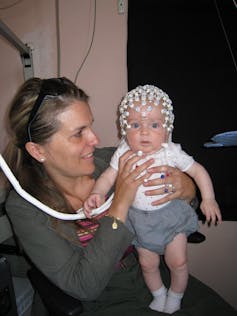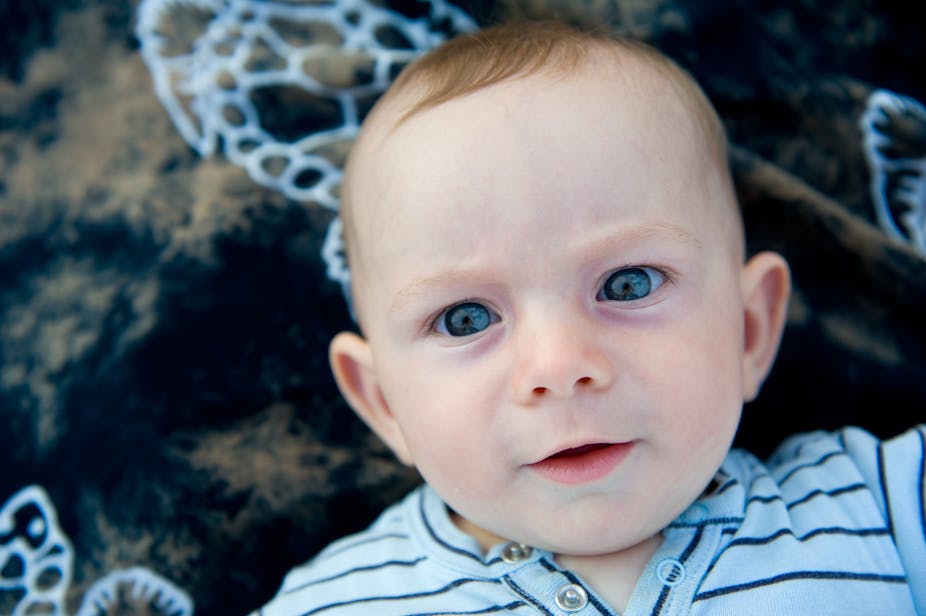Infants develop the ability to consciously process their environment as early as five months of age, according to a study published today in the journal Science.
The team of French and Danish researchers, led by neuroscientist Sid Kouider, discovered a signal in the nervous system of infants that reliably identifies the beginning of visual consciousness, or the ability to see something and recall that you have seen it.
The team set out believing infants had the capacity for conscious reflection, but they had to overcome the barrier that babies could not report their thoughts.
They used electroencephalography (EEG) to record electrical activity in the brains of 80 infants aged five, 12 and 15 months while they were shown pictures of faces and random patterns for a fraction of a second.
When adults are aware of a stimulus, their brains show a two-stage pattern of activity. When they see a moving object, the sensors in the vision centre of the brain activate with a spike of activity.
The signal then moves from the back of the brain to the prefrontal cortex, which deals with higher-level cognition. This is known as the late slow wave.

Conscious awareness begins after the second stage of neural activity reaches a specific threshold.
The new study found this two-stage pattern of brain activity was present in the three groups of infants, though it was weaker and more drawn out in the five-month-olds.
The researchers say neurological markers of visual consciousness may help paediatricians better manage infant pain and anaesthesia.
But they note the research does not provide direct proof of consciousness. “Indeed, it is a genuine philosophical problem whether such a proof can ever be obtained from purely neurophsysiological data,” the paper said.
Professor Louise Newman, Director of the Centre for Developmental Psychiatry & Psychology at Monash University, said the study was novel in its ability to measure the way very young brains register stimuli.
But five months should not be seen as a fixed point at which infants start to process information, she said.
“Although this group has studied five months and up, my suspicion would be that if we had different techniques, young infants – from birth on – would show the capacity of registering these sorts of stimuli.
"Infants are born with quite sophisticated capacities to observe, respond to and interact with the environment, particularly the social environment,” she said.
“Very soon after birth, infants will maintain gaze with their parents or parent: they’ve got quite sophisticated visual tracking capacity from an early age.”
Professor Newman, who has undertaken behavioural studies in two- to four-month olds, said young infant brains were extremely sensitive to their mother’s emotional reaction.
“They learn that ‘if I do this, or if I smile or signal in this way, this is what usually happens’. If you manipulate that so they don’t get that response, they’re very sensitive to that and they show signs that it’s very aversive to them.”
Dr Jenny Richmond, Senior Lecturer at the University of NSW’s School of Psychology, said this type of research was difficult to undertake as babies have short attention spans and can play up when they don’t want to wear the EEG cap any longer.
“In this study, the researchers tested a total of 244 babies, but only 80 provided enough data to be included in the analysis. I wonder to what extent we can generalise the results when data from two thirds of the babies wasn’t analysed,” she said.
“Researchers like me who are interested in infant development are using brain activity to understand changes in memory, cognition, emotion, and social understanding, but consciousness is something that most of us have put in the too hard basket.”
Dr Richmond said that while brain activity measures had a lot of potential in future research, a “multiple-methods approach” was needed.
“I think researchers combining brain activity measures with behaviour will be able to make great strides,” she said.

